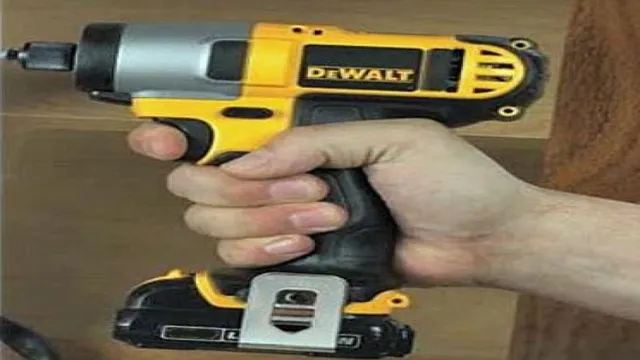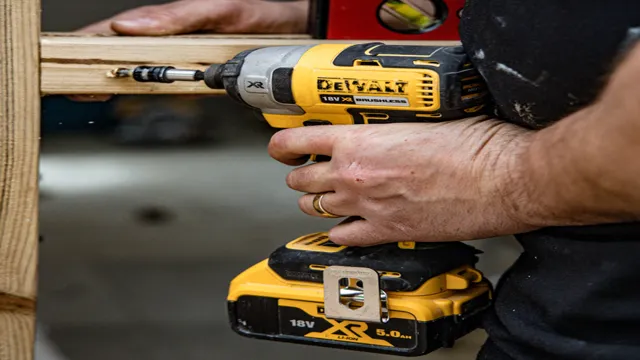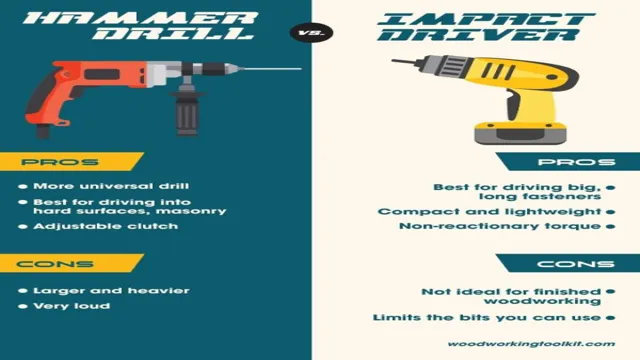
If you’re looking for a powerful tool to handle your DIY projects, an impact driver could be just what you need. Dewalt is a go-to brand for the top-rated impact drivers on the market today, and using one can make your work easier and more efficient. But if you’re new to using an impact driver, you may feel a bit intimidated by its power and complexity.
The good news is that with the right guidance, using an impact driver can become a breeze. In this blog post, we’ll cover how to use an impact driver from Dewalt like a pro so you can tackle any project with ease and confidence. Whether it’s installing cabinets, building furniture, or hanging shelves, you’ll learn everything you need to know to get the job done right.
So, buckle up and get ready to dive into the world of impact drivers!
Get Familiar with Your Impact Driver
If you’re new to impact drivers, it’s essential to understand the basics of how to use them properly. The Dewalt impact driver is a powerful tool that can make your DIY projects much easier. The first thing to know is that an impact driver differs from a regular drill.
It uses rotational and concussive force to drive screws and fasteners, making it ideal for heavy-duty jobs. Before using your Dewalt impact driver, make sure you have the correct bits and attachments for the task at hand. It’s also crucial to adjust the torque setting, so you don’t over-tighten or damage the fasteners.
The forward and reverse switch allows you to change the direction of the tool, making it easy to drive and remove screws. Finally, always wear safety gear and ensure the piece you’re working on is secure to avoid accidents. With a little practice, you’ll quickly become proficient with your Dewalt impact driver and make light work of your projects.
Check the Charger for Power
When you’re getting ready to use your impact driver, it’s important to familiarize yourself with the tool, including how to check the charger to ensure it’s got power. Without a fully charged battery, your driver won’t be able to perform at its best. Before you get started, make sure you plug in the charger and double-check that it’s receiving power from the outlet.
Once connected, look for the charging light, typically a small LED that indicates the battery is charging. Once it’s fully charged, the light should turn green, letting you know it’s ready to power up your impact driver. Remember, maintaining and charging your battery properly will extend its life and ensure you get the most out of your impact driver.

Insert the Battery and Chuck
When it comes to using an impact driver, it’s important to get familiar with the tool before diving in. One of the first steps is inserting the battery and chuck. The battery will provide power to your driver, so make sure it’s fully charged before use.
To insert it, simply slide it into the battery slot until you hear a click. The chuck is where you’ll attach your drill bits or screwdriver tips. To insert it, turn the chuck counterclockwise to open it up, and then insert your chosen bit.
Once it’s securely in place, turn the chuck clockwise to tighten it. It’s important to ensure that both the battery and chuck are well-secured before using your impact driver to prevent any accidents. So, take your time and make sure you’re familiar with these basic components before diving into your project.
Adjust the Torque Setting
Adjust the Torque Setting When it comes to using an impact driver, getting familiar with your tool is essential. One key feature to understand is the torque setting. Torque refers to the rotational force that your impact driver applies to a screw or bolt.
It’s important to adjust the torque setting when using an impact driver to avoid damaging your work surface or the fastener you’re installing. Most impact drivers come with adjustable torque settings, allowing you to customize the amount of rotational force applied. A good rule of thumb is to start with a lower torque setting and gradually increase it until you find the right amount of force to drive the fastener without it stripping or overdriving.
By adjusting the torque setting, you’ll ensure that your impact driver works efficiently and effectively, giving you the results you need without causing damage. So, take the time to get familiar with your tool and adjust the torque setting accordingly to get the job done right.
Using the Impact Driver
If you’re wondering how to use an impact driver, Dewalt has got you covered. First, you’ll need to make sure you have the right bits for your driver. Once you have that sorted, insert the bit into the chuck of the driver and make sure it’s seated properly.
Then, you’ll need to adjust the torque settings on the driver to match the task at hand. With those settings in place, press the trigger and apply pressure to the material you’re driving the screws into. The impact driver will automatically adjust the torque and rotate an impact mechanism inside the tool, providing bursts of additional power to help the screw drive in.
Keep the pressure steady until the screw is fully tightened. In no time, you’ll be able to handle even the toughest driving tasks with ease!
Secure your Material
Impact Driver When it comes to securing your materials, an impact driver can be a game-changer. This powerful tool is designed to deliver high torque and speed, which makes it a great choice for driving screws, bolts, and other fasteners into tough materials like wood, metal, and concrete. Unlike a standard drill, an impact driver uses a rotational and percussive force that helps to reduce the amount of physical effort needed to drive fasteners into these materials.
This means you can get your work done faster and with less fatigue. The impact driver is also great for working in tight spaces where a regular drill may not fit, and its compact size makes it easy to maneuver. So if you’re looking for a reliable tool to help you secure your materials, consider investing in an impact driver.
Insert the Bit into the Chuck
Inserting the bit into the chuck of an impact driver may seem like a simple task, but it’s important to do it correctly for the tool to work efficiently. Firstly, you need to make sure that the chuck is open and ready to receive the bit. Then, carefully place the bit into the opening of the chuck, ensuring that it’s centred and well-aligned.
Next, use your hand to tighten the chuck onto the bit, making sure that it’s firmly in place. Finally, use the impact driver to fully secure the bit by engaging the trigger and releasing it a few times to ensure that the bit is seated correctly. Remember, a loose bit can lead to accidents and inefficiency, so always check that it’s firmly in place before using the impact driver.
Happy drilling!
Squeeze the Trigger to Drive the Screw
Using an impact driver can make driving screws a breeze, but it may take a bit of getting used to. The main thing to remember when using an impact driver is to squeeze the trigger to drive the screw. Unlike a regular drill, where you need to apply force to push the screw into the material, with an impact driver, the tool does the work for you.
All you need to do is hold the driver in place and let it do its job. The impact action helps to generate more torque, allowing you to drive screws into even the toughest materials with ease. So next time you need to tackle a DIY project or assemble furniture, consider using an impact driver to get the job done quickly and efficiently.
Safety Precautions to Keep in Mind
If you’re about to use an impact driver such as the DeWalt model, there are some safety precautions to keep in mind to avoid accidents or injuries. Firstly, always wear appropriate personal protective equipment, including eye and ear protection, and gloves. Secondly, ensure that your work area is clean and free from any obstructions or hazards.
Keep bystanders at a safe distance, and always be aware of your surroundings. Before starting, make sure your impact driver is correctly assembled and firmly secured. When using, maintain a firm grip on the tool and keep it balanced.
Don’t overreach or apply excessive force, and only use the tool for its intended purpose. After use, switch off and disconnect the battery or power source before performing any maintenance or cleaning. By following these safety precautions, you can effectively use an impact driver Dewalt without any issues!
Wear Protective Gear
Wearing appropriate protective gear is a crucial safety precaution that should be taken seriously when participating in activities that pose a risk of injury. Whether you’re biking, skiing, or even just working in your yard, it’s important to properly equip yourself to reduce the likelihood of an accident. Protective gear typically includes helmets, gloves, and pads that are specifically designed to absorb impact and protect vulnerable areas of the body.
Investing in high-quality gear can mean the difference between a minor scrape and a serious injury. So don’t take chances with your well-being – always prioritize safety by wearing the right protective gear for the job.
Ensure Proper Handling of the Driver
As a driver, you are responsible for ensuring that the car is running smoothly and safely. But you should also be mindful of your own safety while driving. One way to do this is to handle the driver properly.
First and foremost, always wear your seatbelt when driving. This simple precaution can save your life in the event of an accident. Secondly, make sure that the driver’s seat and the steering wheel are adjusted to your comfort level.
This not only makes for a more comfortable driving experience but also reduces the chances of getting injured in case of an accident. Last but not least, keep your car in good condition. Regular maintenance checks can help identify potential hazards before they turn into bigger problems.
By following these simple tips, you can ensure that you are taking all the necessary safety precautions to keep yourself and your passengers safe on the road. Keywords: driver, safety precautions, seatbelt, comfort, maintenance.
In Conclusion
With its powerful torque and efficient design, the impact driver Dewalt is a versatile tool that can make any DIY project a breeze. From assembling furniture to installing shelves, this compact and easy-to-use device can help you get the job done quickly and efficiently. Just remember to keep a steady hand and use the appropriate bits and attachments for each task at hand.
With a little practice, you’ll be driving screws like a pro and impressing all your friends with your handy skills. So go ahead and unleash the power of your impact driver Dewalt, and let your DIY dreams become a reality!”
FAQs
What is an impact driver?
An impact driver is a powerful tool that delivers high torque output with minimal effort from the user. It is commonly used for driving screws and tightening bolts.
How is an impact driver different from a regular drill?
An impact driver delivers rotational force with quick bursts of high torque, while a regular drill delivers a consistent, steady force. Impact drivers are better suited for tasks that require more power and faster results.
Can I use an impact driver for drilling holes?
While it is possible to use an impact driver for drilling holes, it is not recommended as it may cause the bit to slip or break. A regular drill is better suited for drilling tasks.
What types of screws can I use with an impact driver?
Impact drivers are designed to work with hexagonal or hex shank screws. They are not compatible with Phillips or flathead screws.
How do I adjust the torque on my impact driver?
Most impact drivers have adjustable torque settings that can be adjusted using a control ring. This allows you to vary the amount of torque output depending on the task at hand.
What safety measures should I take when using an impact driver?
Always wear eye protection and keep your hands clear of the moving parts. Make sure to use the right size and type of bit for the task at hand, and never use the tool in wet or damp conditions.
How do I maintain my impact driver?
Clean the tool after each use and store it in a dry, protected area. Lubricate the moving parts regularly and replace the brushes as needed. Follow the manufacturer’s instructions for any other maintenance procedures.







